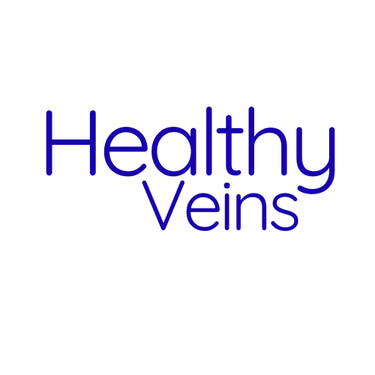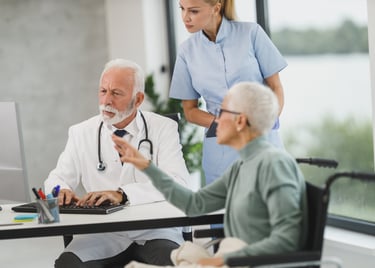Start your journey to healthier veins today!
Questions
Varicose veins FAQs
These are some of the most common questions that patients usually ask us during consultations. They are meant only as a guide not a substitute for obtaining professional help. Please also view our info section for further detailed information about our treatments. If you have any further questions contact us.
What are varicose veins?
Varicose veins are swollen, curvy superficial veins that lie beneath the skin and are often blueish in colour. Varicose veins are different from thread veins (or spider veins) which are small broken veins that lie in the skin but often both will occur together.
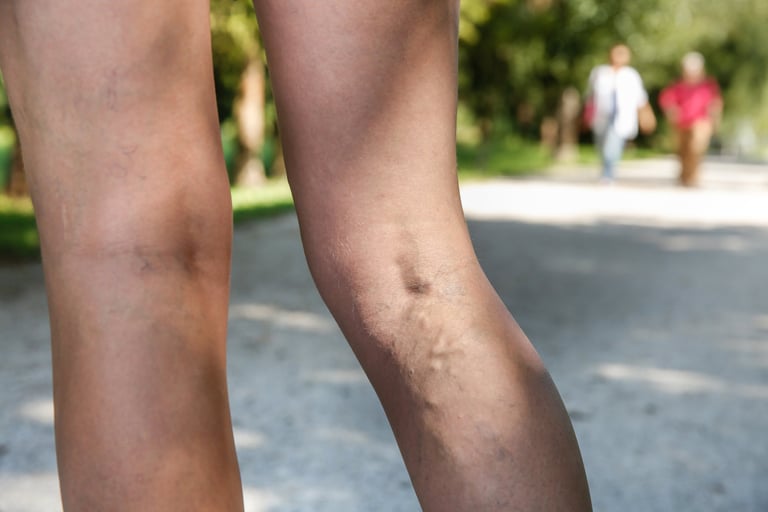

How common are varicose veins?
Varicose veins are common, affecting about 30% of the population and can occur at any age. They occur more commonly in women and are often worse during or after pregnancy. Varicose veins will often run in families but will more commonly present in those who stand for long periods of time as part of their profession e.g. hairdressers, nurses etc.
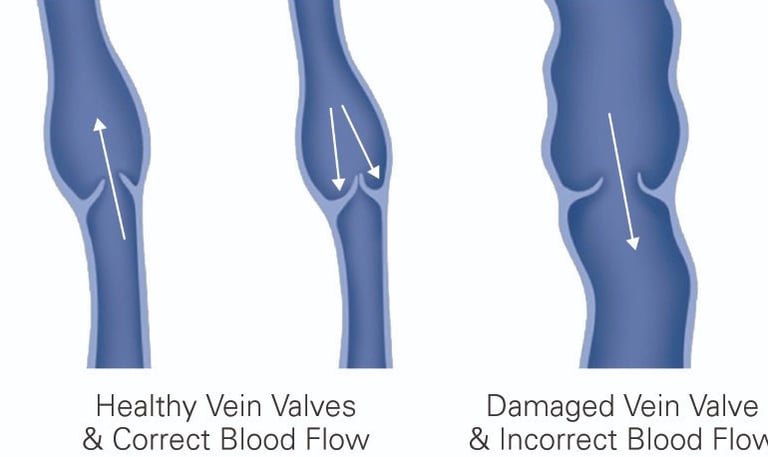

How about how varicose veins arise?
Varicose veins occur because the valves in the superficial veins don’t work properly. Blood often collects in these faulty veins and makes them swell up giving them the typical appearance.
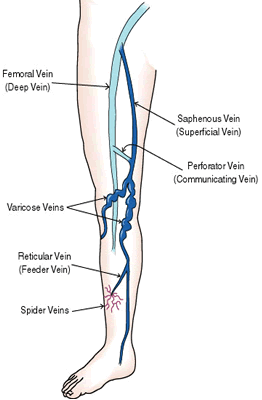

Tell me more about how varicose veins arise?
Often the problematic vein is the one running from the groin all the way down to the ankle (great saphenous vein). In patients with varicose veins, some or all of valves along the length of this vein don’t work properly causing this vein and its branches to swell up giving the typical appearance of varicose veins. These branches are often quite superficial and appear as localised bulges beneath the skin called varicosities. Similarly, the vein that runs from behind the knee to the ankle is affected (the lesser saphenous vein) and sometimes other branches are affected.

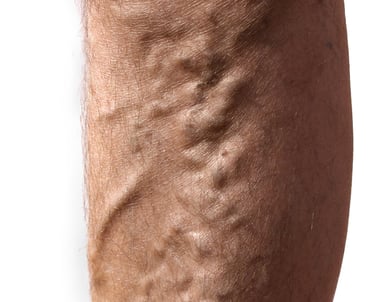
Are my symptoms due to varicose veins?
Typical symptoms of varicose veins include pain and aching, throbbing, a bursting feeling, heavy legs itching and swelling of the ankles. These symptoms are often worse at the end of the day. Varicose veins also cause cosmetic embarrassment. Some people are so embarrassed by the appearance of their veins they avoid wearing shorts or dresses. Research has shown that varicose veins can interfere with quality of life and work and treatment often results in improvement.
Are varicose veins harmful?
Some people with varicose veins can experience complications from their veins, for example superficial thrombophlebitis when the veins can become tender and hard due to inflammation. Sometimes if the skin overlying the varicose veins becomes thin it can give way giving rise to bleeding, this can be quite alarming.
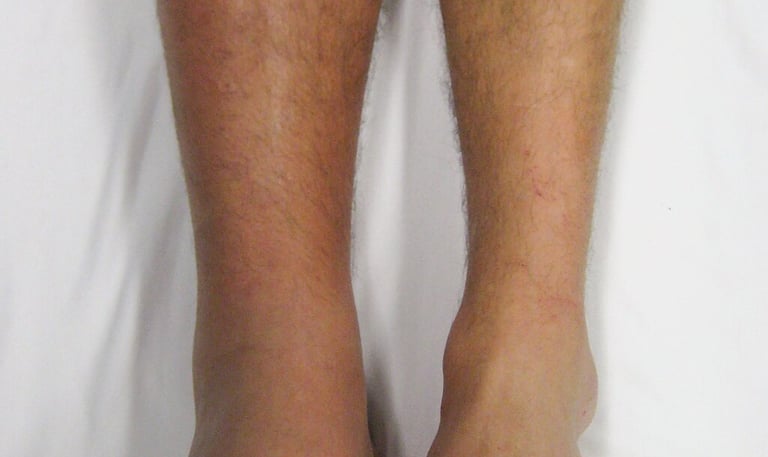

A DVT (deep vein thrombosis) is a clot in the deeper veins that lie in muscle. Varicose veins lie more superficially beneath the skin and are not related to DVT. In some cases superficial thrombophlebitis can lead to a DVT the thrombophlebitis where the superficial and deep veins join in the groin and behind the knee.
What is a DVT and are they related to varicose veins?
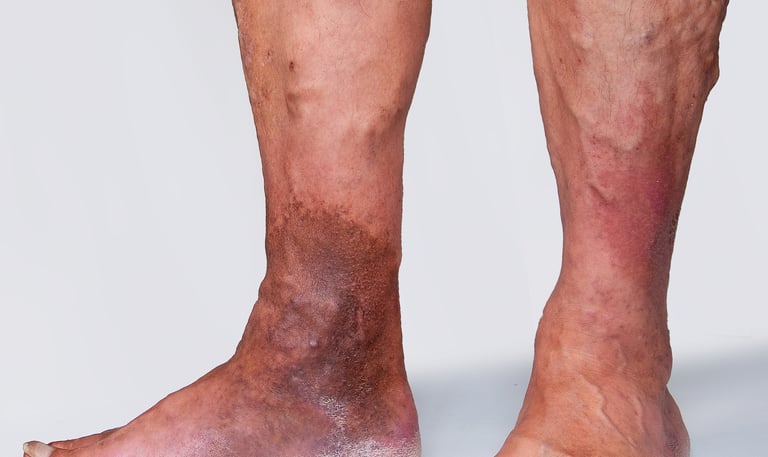

The skin can be affected by varicose veins to varying degrees ranging from itching, eczema, pigmentation and hardening of the skin and in some advanced cases this can lead to skin ulceration. Patients with varicose veins are also at higher risk of leg ulcers. However, a relatively small number of people with varicose veins ultimately develop leg ulcers.
Can varicose veins cause ulcers?
No, although it is always preferable to get a GP letter if you can. Alternatively you can refer yourself to healthy veins without a GP referral.
It is really important to bring a list of your medication to the consultation along with any other details of drug allergies or medical history.
We send letters from our consultations to your GP to keep them informed
Do I need a referral letter?


At your initial 30 min consultation the vascular surgeon who will perform a vein scan (doppler scan) to assess you further and decide the best way to treat your veins. This will involve putting some gel on your leg which can easily be washed off later. The surgeon will expose your whole leg from groin downwards to check your leg veins thoroughly. If you require a chaperone please let the doctor know.
Diagnosing which veins are faulty guides the vascular surgeon on how to treat the vein so this step is very important and is key to success of subsequent treatment. This scan is painless and is similar to scan in pregnancy. It does not involve X-rays.
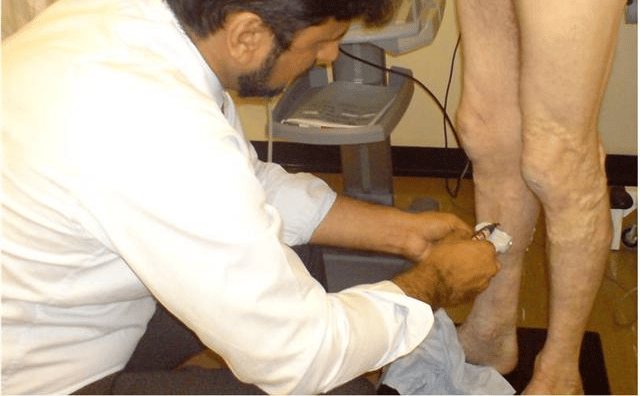

Why do you need a scan and what does it involve?
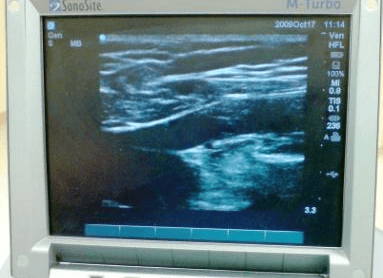

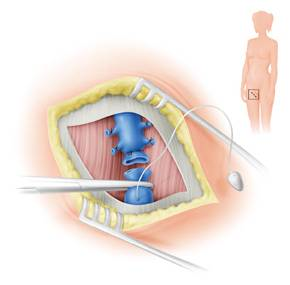

Traditionally varicose veins were previously treated by surgery which involved “stripping” them out which resulted in a longer hospital stay and longer down time. The modern endothermal treatments for varicose veins are a walk in walk out procedure with a quick recovery. The central principle is that faulty veins are sealed off rather than removed. The sealed veins are then gradually absorbed by the body.
My mum had her veins stripped, will I have the same treatment?
Endothermal treatments (using heat) or foam sclerotherapy (using a chemical) both work by disrupting the lining of the vein and eventually sealing it off. For endothermal treatment, A catheter (fine tube) is passed through a tiny nick in the skin and is threaded all the way up the faulty vein. At one end of the probe is a heating element which, as it is pulled back, applies heat onto the surface of the vein sealing it off. Either laser or radiofrequency energy can be used as the heat source. This will treat the main faulty vein but the remaining lumpy veins can be treated by foam sclerotherapy or phlebectomies (surgical removal).
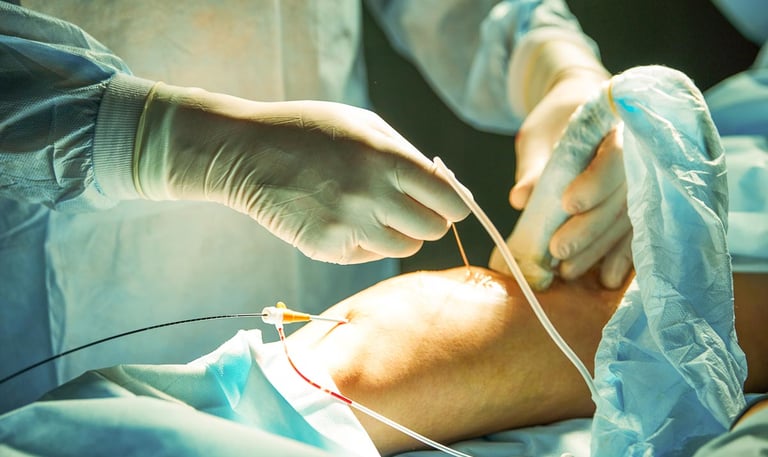

What are the modern ways to treat varicose veins?
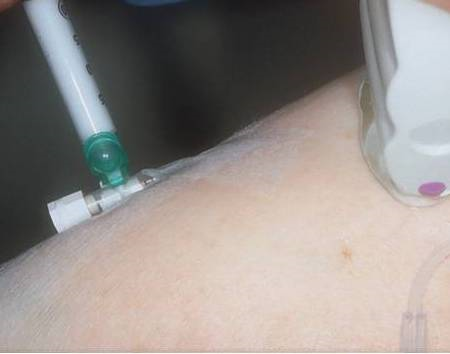

Not all, some are not suitable for endothermal treatments since they may be straight enough to thread a fine tube or catheter
Foam sclerotherapy is ideal for these types of varicose veins. This involves injecting a chemical “sclerosant” mixed with some air into the affected veins. It works in a similar way by disrupting the lining of the vein causing it to block off. This non-operative treatment can be done as a “walk in walk out “procedure in clinic.
Can all veins be treated by endothermal treatments?
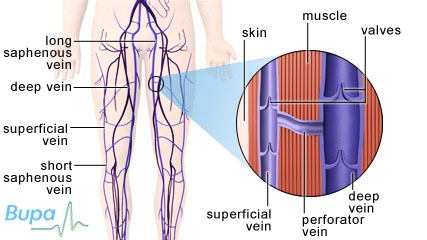

If you block of my veins does it interfere with blood get back to the heart?
No because varicose veins do not work properly anyway ("refluxing") and are working against the good veins so by blocking these it actually makes the rest of your deeper veins more efficient.


I have had my veins for many years and they don't bother me, Do I have to have them treated?
The two main symptoms why patient seek treatment is for symptoms (pain, aching, swelling, ulcers etc) and their appearance. Both are good reasons to have your veins treated. However if you don't have these you can leave them alone.
The "red flag" signs are bleeding and skin changes (eczema, skin pigmentation, thickening of the skin and ulcers) or superficial thrombophlebitis which means we would strongly recommend treatment
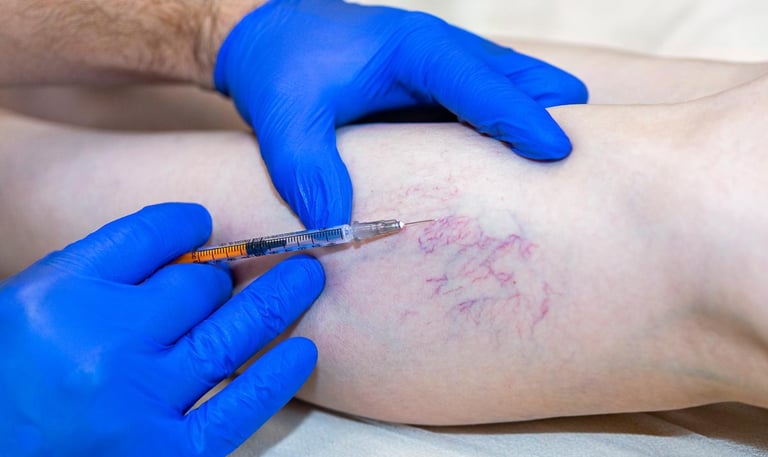

what are thread or spider veins and how can they be treated?
Thread veins (or spider veins) are different to varicose veins. These are very thin veins beneath the skin. They may be an early sign that the veins in your legs are not working properly, even if you do not have any visible varicose veins.
Thread veins are usually painless and do not cause any probems, but may appear unsightly. They can be treated with microsclerotherapy injections as shown in picture
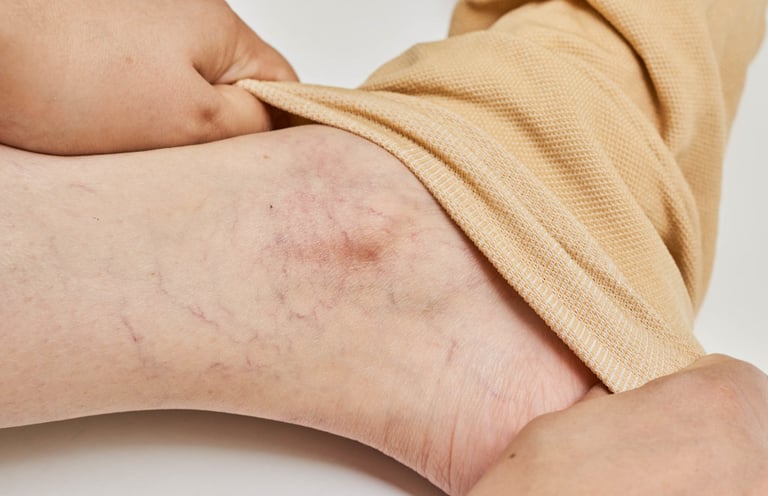

Compression stockings an be used in the short term to control symptoms but they do not cure varicose veins or prevent them. The only definitive treatment are the minimally treatments advised above. Stockings are useful if you have chronic swelling secondary to a DVT when the deep veins have been damaged. They can also be used as part of compression for ulcer treatment and whilst waiting for definitive treatment for your varicose vein treatment. You will also be supplied stockings following treatment to wear for 1-2 weeks. This is really important since the compression is an important part of the treatment to seal off the defective veins. There are difference grades of stockings ranging from class one to class three compression. Before applying them it is really important to make sure your arterial circulation is sufficient, otherwise the stockings can do more harm than good. Your GP practice can usually help with this since they measure the ABPI. Stockings can be quite difficult to apply and remove and there are alternatives nowadays called venous wraps which can be self tightened using velcro. They are particuarlly useful for elderly people or those with arthritis.
Can compression stockings be used for varicose veins?
Every procedures carries risk, the risks with our treatments are minimal. Every effort is made to minimize risks. However we make every patient aware of the risks and obtain inform consent from them.
The most serious risk is of developing a DVT (deep vein thrombosis). This is uncommon and occurs in approximately 1/100 cases. Prior to treatment Mr Choksy or Mr Vitalis will do a VTE risk assessment to assess the risk and if necessary put you on a course of blood thinners to reduce risk. We also advise that you keep as mobile as possible after the procedure, drink plenty and take the blood thinning medications if you require them.
Other risk include minor skin burning, skin pigmentation, small patch of numbness, thrombophlebitis, some lumpiness under the skin, allergic reaction to medication or bandages/stocking, recurrence, bruising and minor bleeding, rarely infection and sometimes the development of thread veins.
What are the risks of minimally invasive treatment of varicose veins?

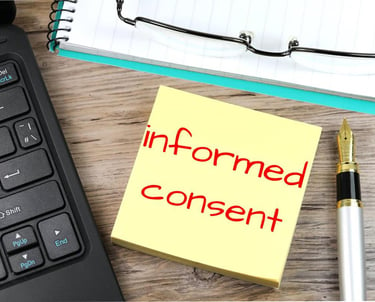
Contact form
We are currently taking bookings for our first clinic at the end of October. Please complete our contact form so we may contact you to arrange an appointment.


Your treatment journey explained
Your journey begins with a thorough initial assessment, followed by treatment of the main vein and then surface veins.
Request a call back
Fill in our contact form and we will call you within 24 hours to start your journey to healthier veins
